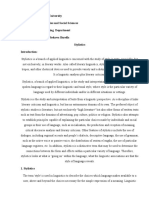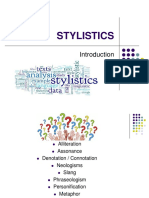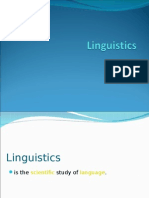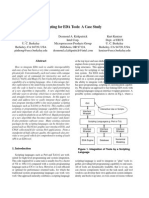2 Style and The Scope of Stylistics
2 Style and The Scope of Stylistics
Uploaded by
Nancy HenakuOriginal Description:
Original Title
Copyright
Available Formats
Share this document
Did you find this document useful?
Is this content inappropriate?
Report this DocumentCopyright:
Available Formats
2 Style and The Scope of Stylistics
2 Style and The Scope of Stylistics
Uploaded by
Nancy HenakuCopyright:
Available Formats
2 Style and the Scope of Stylistics The concept of style has a wide currency since it is applied to various spheres
of human activity characteristic of an individual (to have a personal style), a distinct personality (the style of Hemingway), periods (the baroque style), individual tone adopted in conversation (a patronizing style), mode of tradition (to live in style), living, fashion, etc. Generally speaking, possibilities of selection from inventories of largely synonymous choices enable particular ways (i.e., styles) of their arrangenment. In verbal communication, these inventories are represented not only by the systems of linguistic (viz. phonological, morphological, lexical and syntactic, i.e., the classical inventory of microstylistics), paralinguistic (viz. graphological and suprasegmental features, including paralanguage) and non-linguistic choices (e.g., background music, the quality of printing paper), but also by thematic, textual (macrostylistic, e.g., cohesion) and macrocompositional (e.g., genre) features, including types of speech act, the type of code, etc. Their relevance for the stylistic enquiry lies in their significance (or, more accurately, in their appropriateness) in relation to the intended function of discourse (the sense of stylistic appropriateness or suitability can be seen as a part of communicative competence, cf. Richards et al., 1985). Style as a situationally distinctive use of language (Crystal 1987) then can be seen as an agent integrating all style-making (pragmatic) means and acting as a unifying principle of text construction which pervades all textual levels and which performs, besides this integrating function, also aesthetic, semantic and characterizing functions (cf. Hausenblas 1987, Macurov 1993, ermk 2001, Vachek 1974). The majority of approaches to style agree upon the central concepts of selection and composition (or, using the Classical rhetoric terms, elocutio and dispositio) as being present in every communicative behaviour. However, the scope and the nature of resources (i.e., paradigmatic choices) and their arrangement (i.e., syntagmatic choices) have been the matter of many discussions. Earlier approaches saw style as a result of something being added to or of something deviating from an ordinary use of language (also called foregrounding, e.g., the use of figures of speech, tropes, archaisms as means of ornamentation), or as a result of an individual will (the individualist theory); some approaches even abolished the concept of style altogether (the organic theory) (cf. Barnouw et al. 1989). The rise and the development of linguistics impressionism gave way to positivist approaches which adopted methods of linguistics and other sciences, e.g., statistics for the purpose of authorship identificaton (stylostatistics, forensic linguistics, quantitative stylistics), computer science (corpora-based stylistics), etc. In the English-speaking world, stylistics has mostly been associated with analyses of literary works (literary stylistics) and has been close to literary theory and criticism (cf. Widdowson 1992, Hoffmannov 1993, Mikov 1999), or with approaches differentiating good from bad style (evaluative stylistics) and offering instructions on clear, elegant, effective and sophisticated use of (esp. written) language (e.g., Macpherson 1997; note also the existence of various stylesheets, stylebooks and manuals of style, as well as of writing courses and writing centres at American universities, cf. Knoblauch and Brannon 1984, Harris 1986). In the most recent decades, stylistic explorations have been developing in the framework of functional linguistics and sociolinguistics (sociostylistics), linguistic pragmatics (pragmatic stylistics), discourse analysis (discourse stylistics), critical discourse analysis (radical stylistics), cognitive science (cognitive stylistics, processing stylistics), etc. (cf. Hoffmannov 1993). The very nature of style and the problem of its definition and characterization has stirred much discussion and uncertainty; in fact, this situation parallels a similar problem of offering allembracing and universally accepted definitions of other basic linguistic units (e.g., word or
sentence). From among several hundred existing definitions of style we may adduce here only a few. Style is seen as any particular and somewhat distinctive way of using language (Trask 1997:210), a system of interrelated language means which serves a definite aim in communication (Gaperin 1977:33), projev monosti variace v komunikaci (ermk 2001:46), typov n. individuln zpsob organizace textu a volby lexm a gramatickch prostedk z alternativnch, pedevm iroce synonymnch, resp. ekvivalentnch (ermk 2001:286), individual, unifying character found to be present in any work resulting from intentional activity" (V. Mathesius, cited in Vachek 1974:114), spsob prejavu, ktor vznik cieavedomm vberom, zkonitm usporiadanm a vyuitm jazykovch a mimojazykovch prostriedkov so zreteom na tematiku, situciu, funkciu, autorov zmer a na obsahov zloky prejavu (Mistrk 1997:30). The width of the definition of style delimits the area of operation of stylistics justifying thus its raison dtre in relation to other competing approaches (esp. text linguistics and pragmatics). In a narrower sense, style can be seen as a conscious or unconscious selection from existing optional language features (linguostylistics); obligatory structures of language, such as most of the segmental phonology, the mutation plural, the fixed sequence of auxiliary verbs within complex verb phrases, offer, however, few or no stylistic options at all. It has been suggested that stylistics, employing the concepts and procedures of linguistics in studying the language of (esp. non-literary) texts, may form a separate linguistic stratum with a basic unit of styleme. Stylistics, however, parallels the basic strata in that it draws on their resources; in fact, almost all expressive means of individual linguistic planes can potentially become stylemes. In the wider understanding of the scope of stylistics, which counts on the function of style as an integrator of elements functioning at every level of text structure, stylistics touches upon various other approaches concerned with particular aspects of text. The following subchapters present an overview of those areas of research and attempt to pinpoint their relevance for stylistics, while focusing primarily on the linguistic stylistic resources as these are of main interest for a student of style with a philological background. Since any use of language is an act of communication, we consider it necessary to begin with the theory of verbal communication. This procedure also corresponds with the functional approach to the investigation of style (i.e., the structure of text is motivated by the function it is to perform, cf. Dolnk and Bajzkov 1998) which we are trying to implement here.
You might also like
- Стилістика або лексикологіяDocument93 pagesСтилістика або лексикологіяNataliia Derzhylo100% (1)
- Negotiation VocabularyDocument5 pagesNegotiation Vocabularyb_r_i_d_aNo ratings yet
- 1 - Discourse Analysis PowerpointDocument11 pages1 - Discourse Analysis PowerpointAbbas TaherNo ratings yet
- Basic Methods of Linguistic AnalysisDocument4 pagesBasic Methods of Linguistic Analysismelaniacara80% (5)
- International Negotiator ProfileDocument52 pagesInternational Negotiator ProfileOana StanciuNo ratings yet
- SIOP Sample Lesson PlanDocument4 pagesSIOP Sample Lesson PlanAmanda Wardlow-Cosey100% (1)
- 7 Style and Scope of StylisticsDocument24 pages7 Style and Scope of StylisticsAwais Tareq67% (3)
- Cognitive StylisticsDocument11 pagesCognitive StylisticsDoris Tănase100% (2)
- StylisticsDocument18 pagesStylisticsZarina AbdibaitovaNo ratings yet
- Stylistics DifferencesbetweenapproachesDocument13 pagesStylistics DifferencesbetweenapproachesFauzia YaqoobNo ratings yet
- Basic Notions of StylisticsDocument11 pagesBasic Notions of StylisticsKPD 3015No ratings yet
- (Van Dijk) Discourse Analysis Its Development and ApplicationDocument23 pages(Van Dijk) Discourse Analysis Its Development and Applicationmuutsy100% (2)
- Lecture 1. Stylistics As A Science: 1. The Concept of Style in LinguisticsDocument6 pagesLecture 1. Stylistics As A Science: 1. The Concept of Style in LinguisticsАринаNo ratings yet
- LecturesDocument37 pagesLecturesZhanerkeNo ratings yet
- Towards A Cultural Approach To StylisticDocument18 pagesTowards A Cultural Approach To StylisticLourdes ArguellesNo ratings yet
- Stylistics As A Branch of LinguisticsDocument34 pagesStylistics As A Branch of Linguisticswamanse199283% (6)
- Stylistics and Stylistic VariationDocument3 pagesStylistics and Stylistic VariationBS ENGLISH100% (1)
- Silverstein - Metapragmatic Discourse and Metapragmatic FunctionDocument15 pagesSilverstein - Metapragmatic Discourse and Metapragmatic Functionadamzero100% (3)
- Stylistics Study GuideDocument5 pagesStylistics Study GuidechemwolitNo ratings yet
- Key Terms in Stylistics PDFDocument276 pagesKey Terms in Stylistics PDFhasovic aidda100% (4)
- Stylistics Book For Bs7thDocument276 pagesStylistics Book For Bs7thKB BalochNo ratings yet
- Pedagogical Significance of StylisticsDocument7 pagesPedagogical Significance of Stylisticssuper boyNo ratings yet
- Speech Genres and DiscourseDocument7 pagesSpeech Genres and DiscourseAlikhan ZhussipaliNo ratings yet
- Branches of StylisticsDocument4 pagesBranches of StylisticsMuhammad Afzaal AhmadNo ratings yet
- 11 Stylistics and PragmaticsDocument13 pages11 Stylistics and PragmaticsAwais TareqNo ratings yet
- UntitledDocument5 pagesUntitledANA MARIA BASNILLONo ratings yet
- UntitledDocument10 pagesUntitledАнастасія Іванівна СегедіNo ratings yet
- Genre Analysis - Historical OverviewDocument21 pagesGenre Analysis - Historical OverviewfusumNo ratings yet
- STYLISTICS IntoDocument25 pagesSTYLISTICS IntoДжинси МілаNo ratings yet
- Lecture 1Document13 pagesLecture 1Ніка НаконечнаNo ratings yet
- Stylistics Week 1-2 2024Document6 pagesStylistics Week 1-2 2024Ana GhachavaNo ratings yet
- Lasttttttttttttttttttttttt EDITTINGDocument11 pagesLasttttttttttttttttttttttt EDITTINGmazahraaa1999No ratings yet
- 221 585 1 PBDocument15 pages221 585 1 PBეფრემ ნატროშვილიNo ratings yet
- Stylistics, Sometimescalled Li Nguo-Sty1istics, Isa: I. General Notes On Style and StylisticsDocument61 pagesStylistics, Sometimescalled Li Nguo-Sty1istics, Isa: I. General Notes On Style and StylisticsVladVBNo ratings yet
- Lasttttttttttttttttttttttttttttttttttttttttt Styl PPT EdditingDocument19 pagesLasttttttttttttttttttttttttttttttttttttttttt Styl PPT Edditingmazahraaa1999No ratings yet
- Pragmatics and StylisticsDocument7 pagesPragmatics and StylisticsAri A. ResulNo ratings yet
- Types of Stylistics: 1. General Stylistics or StylisticsDocument5 pagesTypes of Stylistics: 1. General Stylistics or StylisticsReichinelle VargasNo ratings yet
- International EncyclopediaDocument14 pagesInternational EncyclopediaRana Hassan RazaNo ratings yet
- The Teaching of StylisticsDocument8 pagesThe Teaching of StylisticsLourdes Arguelles100% (1)
- Stylistic Theory and Practice Part 1Document99 pagesStylistic Theory and Practice Part 1Azher BeboNo ratings yet
- Style in Literary TranslationDocument13 pagesStyle in Literary TranslationIrman FatoniiNo ratings yet
- Перша іноземнаDocument183 pagesПерша іноземнаNataliia DerzhyloNo ratings yet
- What Is Style and StylisticsDocument160 pagesWhat Is Style and StylisticsBhagyalaxmi Das100% (1)
- Zahraa Last FFFG After LastDocument14 pagesZahraa Last FFFG After Lastmazahraaa1999No ratings yet
- The Concepts of Style and StylisticsDocument9 pagesThe Concepts of Style and StylisticsZaheer AhmadNo ratings yet
- Stylistics - Lecture 1Document4 pagesStylistics - Lecture 1AMJADNo ratings yet
- LinguisticsDocument5 pagesLinguisticssami karemNo ratings yet
- BS (English) Dept of English University of SargodhaDocument36 pagesBS (English) Dept of English University of SargodhaFEROZ KHANNo ratings yet
- Stylistics AND APPROachesDocument5 pagesStylistics AND APPROachesWith Love From KashmirNo ratings yet
- What Linguistics Is.Document8 pagesWhat Linguistics Is.ElyAltabeNo ratings yet
- Handbook of Cognitive Linguistics POLYSEDocument50 pagesHandbook of Cognitive Linguistics POLYSEreinlikemNo ratings yet
- Rhetoric SystemDocument40 pagesRhetoric SystemMushkey AlaNo ratings yet
- Module-2-Material-1Document4 pagesModule-2-Material-1May An YnopiaNo ratings yet
- STYLISTICS Material For Introduction To Linguistic ClassDocument8 pagesSTYLISTICS Material For Introduction To Linguistic ClassRochelle PrieteNo ratings yet
- Definition of Stylistics and Its Key FeaturesDocument3 pagesDefinition of Stylistics and Its Key Featuresshilajit biswasNo ratings yet
- Linguistic RepertoireDocument7 pagesLinguistic RepertoireSumanth .s100% (1)
- Stylistic Analysis of William Blake's Poem "A Poison Tree"Document11 pagesStylistic Analysis of William Blake's Poem "A Poison Tree"Sara SyedNo ratings yet
- СтилистикаСтепановаЭкзаменDocument26 pagesСтилистикаСтепановаЭкзаменafrost879No ratings yet
- Stylistics - 1st SeminarDocument4 pagesStylistics - 1st SeminarАнастасия Брегид50% (2)
- Types of StylisticsDocument26 pagesTypes of Stylisticsgsunuran75% (4)
- LinguisticsDocument23 pagesLinguisticsEzekiel D. Rodriguez92% (12)
- Linguistic modality in Shakespeare Troilus and Cressida: A casa studyFrom EverandLinguistic modality in Shakespeare Troilus and Cressida: A casa studyNo ratings yet
- Test Paper in English 10Document11 pagesTest Paper in English 10Marian Dacara GaliciaNo ratings yet
- APPENDIX 8 Week CurriculumDocument67 pagesAPPENDIX 8 Week CurriculumMaestra NoemiNo ratings yet
- Chopin in 1894Document16 pagesChopin in 1894Jefferson GultianoNo ratings yet
- A Living Interpretation of Allah's Final RevelationDocument474 pagesA Living Interpretation of Allah's Final RevelationAdel HamedNo ratings yet
- Persuasive lETTER WritingDocument19 pagesPersuasive lETTER Writingahmedhameed2020100% (2)
- Multimodal Pragmatics: Kay L. O'Halloran, Sabine Tan and Marissa K. L. EDocument30 pagesMultimodal Pragmatics: Kay L. O'Halloran, Sabine Tan and Marissa K. L. EzaNo ratings yet
- Aspects of LanguageDocument90 pagesAspects of LanguageAna Carmela Salazar LaraNo ratings yet
- SummaryDocument6 pagesSummaryLaura ArroyoNo ratings yet
- Esl P3 QP 2021-2020Document32 pagesEsl P3 QP 2021-2020anh phạmNo ratings yet
- PB Level4b AnnoDocument112 pagesPB Level4b AnnoMicheleLemes100% (1)
- Developing Listening Skills With Authentic MaterialsDocument13 pagesDeveloping Listening Skills With Authentic MaterialsCamille IcasianoNo ratings yet
- 1-Communication and Globalization & World EnglishesDocument22 pages1-Communication and Globalization & World EnglishesGerald Yanag MarianoNo ratings yet
- Quiz: Level A1: Was/ Were 1. Choose The Correct AnswerDocument8 pagesQuiz: Level A1: Was/ Were 1. Choose The Correct AnswerMichelle RamirezNo ratings yet
- GDB (GNU Debugger), Chmod and PATHDocument36 pagesGDB (GNU Debugger), Chmod and PATHASHI KOTHARINo ratings yet
- Galatians, Ephesians, Philippians, and Colossians in E-Prime With Interlinear Greek in IPA (02-01-2013)Document138 pagesGalatians, Ephesians, Philippians, and Colossians in E-Prime With Interlinear Greek in IPA (02-01-2013)David F MaasNo ratings yet
- PHÒNG GD-ktra Cuoi KyDocument4 pagesPHÒNG GD-ktra Cuoi Kytuan leNo ratings yet
- On Phrasal Verbs: Brought It UpDocument5 pagesOn Phrasal Verbs: Brought It Upnana quiroNo ratings yet
- MUET Writing HandoutsDocument5 pagesMUET Writing HandoutsEsther Tong100% (5)
- Tailoring An Interpretable Neural Language Model: Yike Zhang, Pengyuan Zhang, and Yonghong YanDocument15 pagesTailoring An Interpretable Neural Language Model: Yike Zhang, Pengyuan Zhang, and Yonghong Yanantonio ScacchiNo ratings yet
- NZ e 1668015799 Connotation Vs Denotation Powerpoint Ver 1Document17 pagesNZ e 1668015799 Connotation Vs Denotation Powerpoint Ver 1Shwe Yee HtooNo ratings yet
- 8 Grade Grammar Café Active & Passive VoiceDocument6 pages8 Grade Grammar Café Active & Passive VoiceAna DazaNo ratings yet
- Jan 2019Document56 pagesJan 2019Saiman Ranjan TripathyNo ratings yet
- Oral Communication Quarter 1 Summative TestDocument2 pagesOral Communication Quarter 1 Summative TestJoyce NuenaNo ratings yet
- Reading 1Document4 pagesReading 1thuyhai65301No ratings yet
- Scripting For Eda ToolsDocument7 pagesScripting For Eda ToolsravindarsinghNo ratings yet
- A Identifying V-WPS OfficeDocument5 pagesA Identifying V-WPS OfficeElaine MorenoNo ratings yet
- Unit 8 Week 1 Tag QuestionsDocument4 pagesUnit 8 Week 1 Tag QuestionsAlexaNo ratings yet

























































































